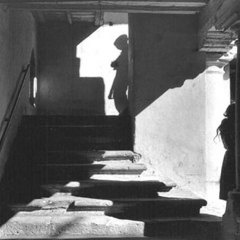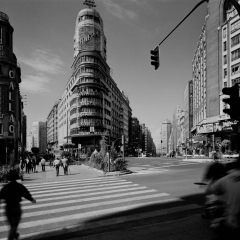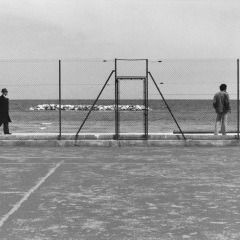City-Society dualism is generally considered one of the most essential and unbreakable bonds of our life. Under a purely pragmatic point of view this need continues to exist, but perhaps in other respects this union proves to be decidedly less solid than we could expect. Sense of community, affection, responsibility and initiative: these are universal concepts that if considered into the urban and daily experience result to be fleeting. That’s why the “smart” attitude cannot but fail to foresee the need to work along this path, thus the much-discussed social evolution might be considered both in a technological and in a human sense.
ghhjkl
It is never so easy to formulate thoughts and predictions about the future, and if in the past the challenge was very difficult, today this attempt appears to be riskier than ever.
Before venturing in this challenge, every self-respecting research, essay or article tries to take stock of the situation and tries to offer a personal and contemporary vision of it. At this stage, a large portion of writings, not to mention almost all of them, focuses on a specific term: revolution. Actually, at the dawn of the new millennium we can finally admit to having reached the pursued permanent revolution, with all the pros and cons it implies.
As heirs of capitalist philosophy, globalization, new physical mobility (due to the very thick transport network and the abundance of modern low-cost flights), children of the rapid spreading of information through remarkable platforms and via web, our world has become a steady stream which keep flowing endlessly from the global to the locale scale, mainly due to the cyberspace support. So the city becomes the collection vessel par excellence of these flows, as well as an experimental space within which the concentration of needs further collaborates in the exchange process and the creative drive. As Mumford revealed in advance, we have shifted from the city that represented the world, to the world that represents the city..
Extremely important is therefore the need for the proper functioning of this organism, which is made up of several collaborating units and ensembles. The most recent trend to favour the collage method, despite the zoning of the city fabric, reinforces the varied and flourishing character of the urban unicum; that density (already mentioned by Jacobs) stimulates and feeds the laborious restlessness of the city.
Such a complex reality can only require the need for careful and cooperative planning above all, to better manage and enhance this diversity which is the greatest wealth that the urban dimension has.
By this point, it is time to take the decisive step and boldly looking further towards that renowned full of promises and perplexities future that presents itself to us with a new slogan, imbued with a bold, aggressive and a little prosaic spirit of our time: being Smart.
Without any particular limitations in terms of size and nature, the achievement of a “Smart City” becomes the goal for each urban entity of our time, as it necessarily has to be converted into more adequate and efficient local solutions. For those unfamiliar with it, the concept of Smart City is generally conceived as the use of digital technologies meant to modify and intensify the relationship between urban space and citizenship, to improve services and life quality of these. As mentioned before, the reality of the individual city properly refers, once again, to a larger project linked to a global vision.
Naturally, most of the interest aroused by these initiatives normally falls on the technological and innovative aspect, tending to overshadow the other fundamental protagonist of the story: the socalled “Community”. This precise consideration has to do with some of the points regarding the real role community can and should hold to support this effort.
Several creative researches and experiments are currently underway by scientific and engineering companies all over the world. The common direction remains unchanged not only under the urban planning point of view, committed to fostering the dialogue of diversified centres through infrastructures and sharing spaces, but also from the architectural one which increasingly aims at the realization of products as flexible and inclusive as possible. Connection, comparison, collaboration: these are the key concepts that act as a common denominator.
All these measures are certainly positive and encouraging, so long as they are handled within the delicate limits of ethics and the individual’s safety. But unfortunately, they are not enough.
The community first should marry and pursue these principles under an active and proactive attitude, which is exercised only in a small part. The feeling of the community in its proper sense is almost unknown to us.
Within city contexts, and even more in large metropolises, globalization and social movements have reported a process of disaffection and estrangement from urban life. That is because of the great global developments discussed previously, which are struggling to find satisfactory correspondence in everyday life. In some ways, it feels like we recognize a sort of virtual dwelling that transcends the place in which we are temporarily living.
This standing alienation was identified by Zygmunt Bauman as an entirely modern invention. In this regard, Mumford provides us an interesting reflection on the dynamics of urban life during the mercantile exchanges of the medieval squares. Here, sellers and buyers coming from different countries used to meet at a specific meeting point. Here, they carried out negotiations to which everyone necessarily had to submit to the same rules and moral standards, besides the fact that they also established direct physical and human relationships that somehow contributed to the familiarisation process.
To this reality comes out the legacy of the capitalist experience too, being the homeland of individualism unrelated to the ethical principalsin favour of calculus and utilitarianism. Our time, albeit full of potentiality and energies, is forced to face a fragmentation and an ideological crisis that challenges our sense of identity, as well as provoking a painful lack of trust in the institutions.
This is not a fierce criticism of the contemporary, nor it’s the alarmist denunciation of an already sealed future. It is an awareness that invites us to reflect as a new starting point.
Coming back to the social participation opportunities for a smart future, even Carlo Ratti in “Smart city, smart citizen” provides us interesting ideas. In presenting the various initiatives, the big data component takes on a role of primary importance as the computer network, through the retrieval of data and images produced in mass by the so-called digital citizens, will have to serve as a huge collector capable of ordering and reworking each information as a result of a new visualization useful for subsequent considerations. Besides the Orwellian restlessness, this approach is certainly full of opportunities. What does not seem successful is, once again, the real participation of the individual. In this case, the citizen-user maintains a mostly passive attitude towards the system that surrounds him and, as a result, it converts him to a simple sensor. This does not seem the way for effective involvement of the population but Ratti, aware of the problem, suggests giving back to the user the re-elaboration achieved from the analysis of the data by using graphs or indicators. In this case, it could serve in the ecological and sustainable field to raise awareness and push citizens to behave more responsibly.
This second hypothesis comes much closer to the aim of encouraging an active participation of the population, although the technological use as the author of the process remains irreplaceable. This focal point could be related to the fact that the virtual world and the tangible world are struggling to link up, and everything that is part of cyberspace somehow seems very distant and does not involve us directly. This limbo tends to desensitize us in many aspects, and probably this could contribute to the weakening of bonds and shared values, as well as to the indifference in collective needs. Perhaps the daily habit of a more empirical and concrete approach to social problems (the ecological case is certainly one of the most appropriate and burning example) may need to stimulate and encourage autonomous initiatives in parallel to the technological rise. The small goal must not lose its strength. Indeed, the practical action and the direct exchange between strangers in places of sharing helps us not to lose that innate and restless sensitivity that characterizes man and makes him what he is. The physical-sensory and intellectual perceptive dimension is an instrument that cannot and must not be forgotten but rather kept in continuous exercise.
Linked to this, we may mention Roberto Masiero, professor at the IUAV architecture faculty in Venice who in 2014, together with Aldo Bonomi, publishes “From smart city to smart land”. The same year the Gi.Ar.P. president Enrico Lain, during an interview concerning the term “smart”, specified that it does not refer to a technological matter but a mindset that uses informatics “to achieve a collective freedom dimension”¹.
In concluding my suggestion, I leave the word to two much more distinguished architects who wrote in their book that “maybe, being smart means trying to keep reality together with life, science with art, thinking with doing”².
Translated into English by Francesco Merra.
¹ A cura di Cinzia Simoni e Alessandro Tognon, Progetti di riqualificazione urbana per la città, Padova, Aiòn edizioni, 2014.
² A. Bonomi, R. Masiero, Dalla smart city alla smart land, Marsilio, 2014.
– Z. Bauman, Città di paure, città di speranze, Castelvecchi, 2008.
– L. Mumford, The City in History. Its Origins, Its Trasformations, and Its Prospects, Harcourt Brace, Jovanovich, 1961.
– C. Ratti, Smart city, smart citizen, Egea, Milano, 2013.














